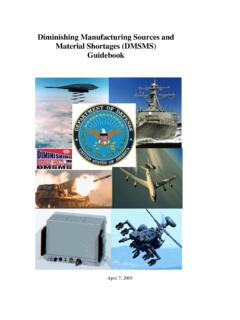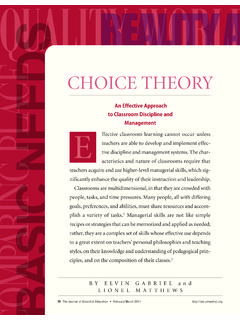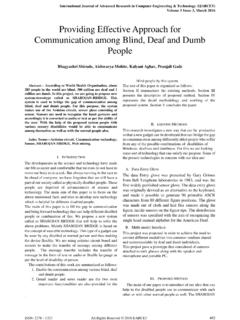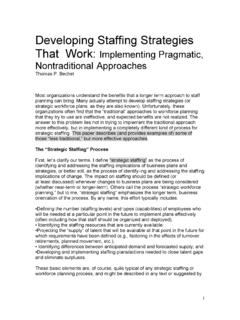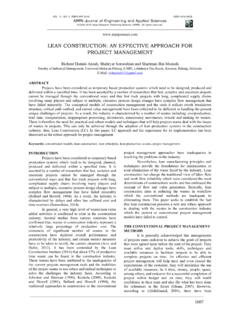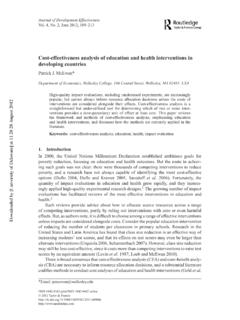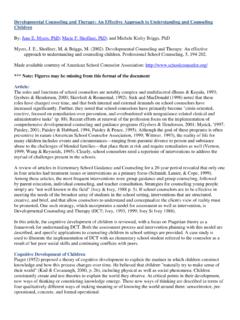Transcription of Collaborative Problem Solving: An Effective Approach For ...
1 Collaborative Problem solving : An Effective Approach For Managing Conflict In The Workplace J. Stuart Ablon and Seth Bernstein Abstract Collaborative Problem solving (CPS) is a method of conflict resolution that was originally developed for working with very difficult children. However, CPS is not just for kids. It is an evidence based practice that can be adapted for use in helping managers to work effectively with their staff when, inevitably, conflict arises. The core of CPS is Plan B, a clear, multi-step process for working through conflict. This article describes the conceptual underpinnings of CPS and provides directions, illustrated by examples, for executing Plan B. - 2 - Introduction The workplace is a complex interpersonal environment where conflict inevitably occurs. When handled poorly, conflict undermines relationships, team performance, and morale. It keeps managers and staff alike up at night, dreading the start of a new day at work.
2 When handled well, working though conflict can build trust and create a positive work environment where people work effectively together. College level business programs have become increasingly aware of the psychological and sociological complexity of the work environment. They now routinely offer courses that address organizational behavior, job stress, and managing people. There are courses offered that teach conflict resolution skills. These are designed to teach students how to handle labor-management disputes (Beer, J. & Stief, E., 1997; Deutsch, M. & Coleman, P., 2000) as well as how to be successful in business negotiations (Fisher, R & Ury, W., 1991). However, they are not designed to teach prospective managers a systematic Approach for handling day to day conflict in the workplace This article has been written to address that need. Conflict There are many theories which attempt to explain the nature of conflict and a wide range of practical approaches have been developed for managing it (Wilmot and Hocker, 2001).
3 Goleman s (1998) theory of emotional intelligence is widely known in the business community because its skill-based Approach lends itself well to a results-driven environment (Jordan and Troth, 2004, 2006). In Goleman s model, the skills needed to manage conflict are a combination of Social Awareness and Relationship Management..CPS represents an example of a specific methodology for learning the listening, communication, and negotiating skills that are needed to successfully negotiate and resolve disagreements and tense situations. Collaborative Problem solving (CPS) is a method of conflict resolution that was originally developed for working with very difficult children. It teaches parents, teachers, and mental health professionals how to understand and work together with challenging kids to solve problems in mutually satisfactory ways. It is not well known to the business community or business literature.
4 CPS was originated by Dr. Ross Greene and subsequently developed by Dr. Greene and Dr. Stuart Ablon, and their associates at Massachusetts General Hospital and the Harvard Medical School. An initial series of brief reports (Ablon, S., Edwards, G., Green, R., Goring, J., Henin, A., Markey, J., Monuteaux, M., Rabbitt, S., Reazer-Blakely, L., 2004) documenting the effectiveness of the Approach in reducing conflict at home with very challenging children was followed by a study that demonstrated how CPS could be used to reduce the use of restraints in child and adolescent psychiatric inpatient units (Green, R.,Ablon, S., & Martin, A. (2006)) and residential treatment programs (Martin, A., Mohr, W., Olson, J., & Pumariega, A. 2009). Their - 3 - comprehensive Approach for working with difficult children (Green, R. 2001; Green, R. & Ablon, S., 2006) has been widely disseminated through seminars and workshops offered throughout the United States.
5 As more people have learned CPS, it has been applied in an increasingly wide range of settings with diverse populations and provocative results. Its effectiveness has been demonstrated everywhere from homes and schools to residential treatment facilities, hospitals and even corrections facilities. We have found this Approach to be coherent, accessible, and applicable to the workplace setting. The CPS Philosophy It is essential for the managers to establish an expectation among themselves and with their staff that conflict will be handled in a consistent manner. Managers also need to have and to communicate a clear philosophy of conflict management. The original philosophy of CPS is that kids do well if they can. If they can t, we adults need to figure out why, so we can help. Translated into the workplace, this reads, staff do well at their jobs if they can. If they can t, managers need to help them figure out why, so they can.
6 The CPS philosophy informs us that the manager s explanation of a staff s behavior, attitude, etc. will guide his or her intervention with that staff member. Conventional wisdom tells the manager that staff s challenging behavior is usually designed to get things or avoid things, such as getting attention or avoiding work. Flowing from a conventional explanation like this, a conventional response to such behavior would be to ignore it or try to motivate more compliant behavior. There certainly is a logic to conventional wisdom and some value to the conventional response if conventional explanations are correct. Staff generally do respond to consistent rewards and punishments and also to being ignored (which is a form of punishment). These approaches can work. They just don t work as effectively in most situations as a transparent, systematic, and Collaborative method of conflict resolution.
7 And they definitely don t tend to work in the most challenging of circumstances and can in fact be counterproductive. The CPS Approach To Managing Conflict When presented with conflict or an expectation that a staff member is not meeting, managers generally have three choices: Plan A: impose their will; Plan B: Collaborative Problem solving ; Plan C: drop the issue, at least for now. Which option managers chose depends on the long term and short term goals managers have with individual staff; how far along they and their staff are in realizing those goals; and the situation/ Problem at hand. As managers come to know more about each of these Plans and as they improve their understanding of how each of - 4 - their staff respond to them in different situations, they will gain more confident in which Plan to chose at any given point in time. In executing Plan A, managers are exercising their prerogative as the person in authority.
8 This is what French and Raven (1959) refer to as legitimate power. There is nothing inherently wrong with this Approach . Sometimes it represents the shortest distance between two points. Sometimes staff really want their manager to make an executive decision and get on with it rather than take the time needed to arrive at a consensus. More often, Plan A is experienced by staff in the same way they experienced a parent saying, because I said so. Staff may comply because there was no real choice, but they remain angry and consequently find passive ways to resist. Managers, may be able to tell themselves, my staff did what I told them to do , but it is highly likely that the situations which required the boss to give these orders will keep popping up. Plan A can be Effective ; it can also be risky and unproductive. It rarely solves tough problems in durable ways. It certainly does not teach staff the skills that would be needed to resolve such issues in the future without the intervention of their managers.
9 It definitely does not build the kind of Collaborative relationships that are key to Effective management in organizations that require group Problem solving to succeed. Plan C has obvious advantages. Pick your battles is sage and time-tested advice, but that there is a significant downside to this strategy. Managers are likely to feel that when they execute Plan C they will be viewed by staff as dodging the issue or capitulating. They might then be concerned that their staff, in observing their managers avoid a conflict, will be emboldened to continue with this behavior. To execute Plan C properly, the manager must recognize that Plan C is not giving in. It is a well thought out decision. What is giving in? A failed Plan A leading to Plan C! In other words, the manager tries to make staff do something, it does not occur, and then the manager drops the expectation. The key to using Plan C successfully is to only use it tactically.
10 Managers use it when they have reasoned that a particular conflict is not worth the time it will take to effectively work it through; because the timing is not right for dealing with the issue; or simply because they or their organizations have bigger fish to fry for the moment. Plan B is the middle way. Plan B is the heart and soul of CPS: it is Collaborative Problem solving . At the end of a successfully executed Plan B the manger can say to him or herself, we worked it out. We solved the Obviously CPS did not invent the idea that people at different levels of authority can jointly work out their problems. What CPS does exceptionally well is to describe a series of research-based and easily understandable steps for accomplishing this goal. - 5 - Plan B Our description of Plan B below differs somewhat from how Plan B is described in working with challenging kids. The modifications to Plan B flow from our experience applying it in the workplace.
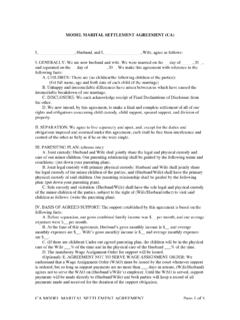

![PARENTING PLAN Father/Mother [no.] child/ren Child/ren ...](/cache/preview/1/f/9/5/3/4/9/0/thumb-1f953490d6f503c971bb975ed38df46c.jpg)

